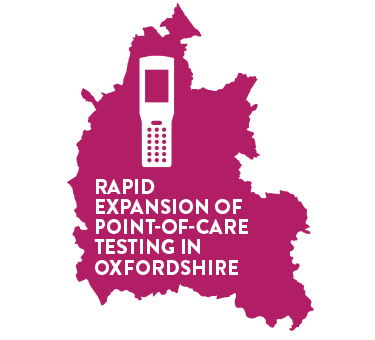Global point of care
MEETING THE CHALLENGES OF 21ST
CENTURY DIAGNOSTICS
Two Oxfordshire NHS Foundation Trusts, UK: a with-patient testing case study
Healthcare organizations continue to be challenged to provide quality healthcare in the face of escalating costs and funding constraints. In addition, to better serve a broad patient population, centralized care is moving to peripheral settings where traditional care delivery models are not as effective. New models of healthcare delivery, like point of care, are necessary to help providers:
- Generate efficiency gains
- Eliminate waste
- Optimise processes
- Drive more appropriate use of resources
While hospital staff are motivated to explore new care models, they lack the time to do it alone. It is up to the point-of-care industry to champion new models of care, not just with technological innovation, but through shared experience and commitment. Abbott Point of Care is doing just that with the i-STAT System. Working with Abbott, laboratory professionals have built a with-patient testing service across two Oxfordshire NHS Trusts.*
* Oxford University Hospitals NHS Foundation Trust and Oxford Health NHS Foundation Trust.c
The results shown here are from specific healthcare organizations and may differ from those achieved by other institutions.

POINT-OF-CARE TESTING
- 7 million tests per year
- 250,000 blood gas tests
- 500,000 blood glucose tests
IMPROVING THE PATHWAY
- Point-of-care diagnostics give rapid results, enabling patients to be treated within 30 minutes of arrival at hospital1
RAPID EXPANSION OF POINT OF CARE TO COMMUNITY FACILITIES
- Abingdon Community Hospital
- Chipping Norton Health Centre
- East Oxford Health Centre
- Witney Community Hospital
EXPANSION OF WITH-PATIENT TESTING IN OXFORDSHIRE
With-patient testing with the i-STAT System has enabled clinicians to perform diagnostic blood testing at the patient’s bedside in multiple departments at the John Radcliffe Hospital. Integrating with-patient testing directly into the patient-care pathway has driven multiple, system-wide efficiencies. At the time of publication, six departments had integrated the i-STAT System into patient pathways:
- Emergency department
- Radiology department
- Ambulatory care department
- Gynaecology
- Neonatal unit
- Cardiovascular operating room
This service has now been extended to multiple community facilities throughout Oxfordshire. Each facility has a range of testing options suitable to patient and infrastructure requirements. Point-of-care diagnostics give rapid results, enabling patients to be treated within 30 minutes of arrival at hospital.1
ABINGDON COMMUNITY HOSPITAL
CHEM8+, PT/INR, Troponin, CG4+
CHIPPING NORTON HEALTH CENTRE
E3+
EAST OXFORD HEALTH CENTRE
CHEM8+
WITNEY COMMUNITY HOSPITAL
CHEM8+, PT/INR, Troponin, CG4+
FOCUS ON THE EMERGENCY MULTIDISCIPLINARY UNIT
Over 60% of patients managed on a purely ambulatory path, with no need for a hospital bed2
Open 7 days a week from 8am-8pm on weekdays (10am-4pm on weekends)
Average patient age is 80
X-ray facilities
Majority of patients have suspected heart attacks, strokes, head injuries or may need surgery
Seeking a credible and dependable alternative to acute hospital admission, and with proven experience using the i-STAT System , Oxfordshire NHS Trusts established the Emergency Multidisciplinary Unit (EMU) in 2012. An innovative care model for older patients living with frailty, the unit provides accessible, rapid and multidisciplinary diagnosis and treatment in the community. Originally established at Abingdon Community Hospital, the EMU model is now in place at Witney Community Hospital and has influenced units at the John Radcliffe, Horton General and Henley Community Hospitals.
The care process in the EMU is personalized – tailored to risk, patient and carer preference. Supported by point-of-care testing, over 60% of patients are managed in the EMU on a purely ambulatory path, eliminating the need for a hospital bed.2
EMU PATHWAY: TRIAGE AND
DIAGNOSIS TO SUPPORT
AMBULATORY DECISIONS
The i-STAT System fulfills these requirements. The model currently in use with the EMU is transferrable to different locations and departments. Diagnostic testing hubs in the community setting are currently in development throughout the UK.

Successfully implementing with-patient testing in the EMU setting highlighted three elements of best practice:
GOVERNANCE
Aim to produce results under the same governance standards that apply to the laboratory ISO 22870:2016 point-of-care testing
INFORMATION FLOW (CONNECTIVITY)
Any point-of-care device purchased should be data networkable unless there is no alternative available
Standardisation
Using the same instrument for multiple applications and in multiple locations reduces the total resource required
THE FUTURE OF COMMUNITY CARE
Building on the success of community care linked to the central lab, the Early Pregnancy Assessment Clinic (EPAC) within the John Radcliffe is currently moving to the community. With up to 6000 appointments a year, this specialist unit provides care for women with problems in early pregnancy, such as a miscarriage or ectopic pregnancy. The John Radcliffe sought a diagnostic solution that would allow the clinic to move to the community. The primary test needed for this clinical situation is the β-hCG test, which the i-STAT System offers. As IT connectivity with the central lab of the John Radcliffe is already in place, the clinic move should be up and running in early 2019.
As new models of care become a reality across healthcare systems, diagnostic testing must be reliably available in primary care and community health centers. With-patient testing via the i-STAT and i-STAT Alinity Systems will continue to lead the way, supported by robust IT infrastructure, innovative handheld diagnostics and confident healthcare professionals.
References
- Emergency Multidisciplinary Unit: Oxford Health NHS Foundation Trust. Available from https://www.gov.uk/government/uploads/system/uploads/attachment_data/file/459208/ Oxford_Health_EMU.pdf. Accessed 31 January 2018.
- Lasserson D. The Out of Hospital Emergency Multidisciplinary Unit. Available from https://innovation.ox.ac.uk/wp-content/uploads/2014/08/Out-of-Hospital-EMUDan-Lasserson.pdf. Accessed 31 January 2018

